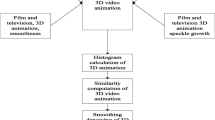Abstract
Animation ink is a unique form of artistic expression, which is taken from traditional ink painting, and through the continuous exploration and advancement of animators, it has gradually formed its language system and formed a unique artistic style in expression and mood shaping. In this paper, the spatial domain noise reduction method and the transform domain noise reduction method are integrated, and the two types of algorithms complement each other to obtain a better denoising effect. The local pixel block matching algorithm is used to select similar block samples, which makes the covariance calculated by a principal component analysis more accurate in the next step, and then distinguishes the signal from the noise well. The adaptive bilateral filtering algorithm based on residual noise variance estimation uses the spatial proximity and pixel value similarity in the animated ink and wash image under the premise of the optimal set of filtering parameters, and adopts the local weighted average method to obtain the recovered animated ink and wash image. To effectively protect and enhance the detail information such as edges of the animated ink and wash image for animated ink and wash character modeling design. The method in this paper makes full use of the properties between spatial pixels of animated ink and wash images with both rotation invariance and translation invariance. The experimental results on the test database show that the method in this paper can extract features better. The purpose of this paper is to explore how to inherit and bring into play the fine cultural and artistic essence of ink art, to uncover the expressive elements applicable to animation ink character modeling design, and to make them reasonably and effectively used in the creation of animation ink character modeling to maintain the vitality of animation ink character modeling design.








Similar content being viewed by others
Explore related subjects
Discover the latest articles, news and stories from top researchers in related subjects.References
Caccia M, Bonizzoni L, Martini M et al (2021) Behind the scene of “The holy family with St. Anne and the young St. John” by Bernardino Luini: a computer-assisted method to unveil the underdrawings. Appl Spectrosc 75(3):274–286
Pettee M, Shimmin C, Duhaime D et al. (2019) Beyond imitation: generative and variational choreography via machine learning[J]. arXiv preprint arXiv:1907.05297
Thommes M, Wang T, Zhao Q et al (2019) Designing metabolic division of labor in microbial communities[J]. MSystems 4(2):e00263–e00318
Bhattacharjee S, Chaudhuri P (2020) A survey on sketch based content creation: from the desktop to virtual and augmented reality[C]. In: Computer Graphics Forum, 39(2): 757–780
Tanis-Kanbur MB, Kumtepeli V, Kanbur BB et al (2021) Transient prediction of nanoparticle-laden droplet drying patterns through dynamic mode decomposition. Langmuir 37(8):2787–2799
Umenhoffer T, Szirmay-Kalos L, Szécsi L et al (2018) An image-based method for animated stroke rendering. Vis Comput 34(6):817–827
Vanhoof C, Bacon JR, Ellis AT et al (2019) 2019 atomic spectrometry update–a review of advances in X-ray fluorescence spectrometry and its special applications. J Anal Atomic Spectrom 34(9):1750–1767
Khan FA, Khelifi F, Tahir MA et al (2018) Dissimilarity Gaussian mixture models for efficient offline handwritten text-independent identification using SIFT and RootSIFT descriptors. IEEE Trans Inf Forensics Secur 14(2):289–303
Hogräfer M, Heitzler M, Schulz HJ (2020) The state of the art in map‐like visualization[C]. In: Computer Graphics Forum, 39(3): 647–674
Kinstlinger IS, Saxton SH, Calderon GA et al (2020) Generation of model tissues with dendritic vascular networks via sacrificial laser-sintered carbohydrate templates. Nat Biomed Eng 4(9):916–932
Alam M, Hasan M, Faiyaz IH et al (2019) Augmented reality education system in developing countries. Electron Imaging 2019(2):183-1-183–11
Zhang J, Zhou Y, Xia K et al (2020) A novel automatic image segmentation method for Chinese literati paintings using multi-view fuzzy clustering technology. Multimed Syst 26(1):37–51
Santos I, Castro L, Rodriguez-Fernandez N et al (2021) Artificial neural networks and deep learning in the visual arts: a review. Neural Comput Appl 33:121–157
Yang S, Yang S, Yang W et al (2018) Automatic portrait oil painter: joint domain stylization for portrait images. Multimed Tools Appl 77(13):16113–16130
Xue Y, Ju Z, Xiang K et al (2018) Multimodal human hand motion sensing and analysis—a review. IEEE Trans Cogn Dev Syst 11(2):162–175
Mayer RE (2019) Thirty years of research on online learning. Appl Cogn Psychol 33(2):152–159
Mukhamadeyeva R (2019) Research and development of additive technology in industrial manufacturing of new products in Kazakhstan. Int J Res-Granthaalayah 7(2):121–133
Rees D, Laramee RS (2019) A survey of information visualization books[C]. In: Computer Graphics Forum, 38(1): 610–646
Naji S, Jalab HA, Kareem SA (2019) A survey on skin detection in colored images. Artif Intell Rev 52(2):1041–1087
Chen J, Wang D, Xie I, Quan Lu (2018) Image annotation tactics: transitions, strategies and efficiency. Inf Process Manag 54(6):985–1001
Maçãs C, Lourenço N, Machado P (2020) Evolving visual artefacts based on consumption patterns. Int J Arts Technol 12(1):60–83
Grimaldi M, Rodrigues MHWL, Rodrigues DWL (2021) The teaching of geometric representation techniques at the fine arts school of the Federal University of Rio de Janeiro[C]. In: International conference on geometry and graphics. Springer, Cham, pp. 651–661
Author information
Authors and Affiliations
Corresponding author
Ethics declarations
Conflict of interest
We declare that there is no conflict of interest.
Additional information
Publisher's Note
Springer Nature remains neutral with regard to jurisdictional claims in published maps and institutional affiliations.
Rights and permissions
About this article
Cite this article
Zhang, X. Animated ink and wash character modeling and simulation based on automatic intelligent matching of local pixel blocks. Neural Comput & Applic 35, 4307–4317 (2023). https://doi.org/10.1007/s00521-022-06991-2
Received:
Accepted:
Published:
Issue Date:
DOI: https://doi.org/10.1007/s00521-022-06991-2




